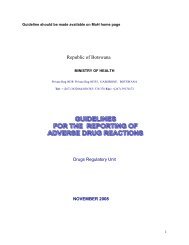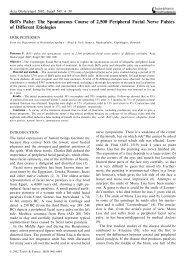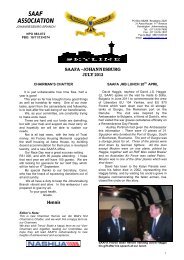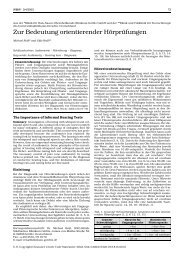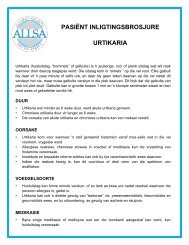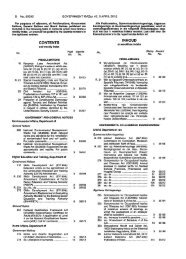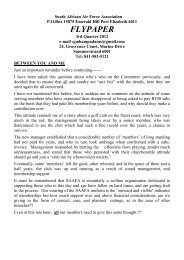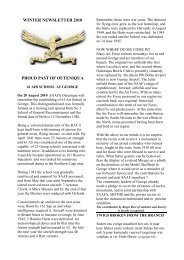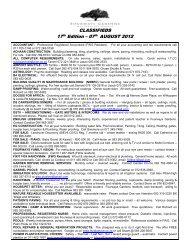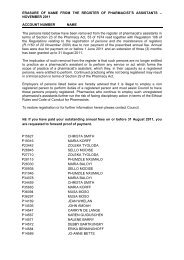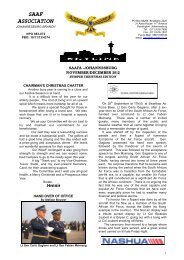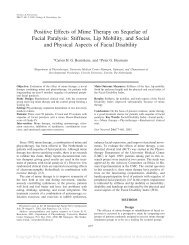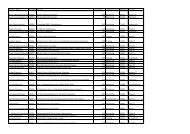The syndromic status of sclerosteosis and van Buchem ... - Admin
The syndromic status of sclerosteosis and van Buchem ... - Admin
The syndromic status of sclerosteosis and van Buchem ... - Admin
Create successful ePaper yourself
Turn your PDF publications into a flip-book with our unique Google optimized e-Paper software.
Clinical Genetics 1984: 25: 175-181<br />
<strong>The</strong> <strong>syndromic</strong> <strong>status</strong> <strong>of</strong> <strong>sclerosteosis</strong><br />
<strong>and</strong> <strong>van</strong> <strong>Buchem</strong> disease<br />
P. BEIGHTON', A. BARNARD', H. HAMERSMA3 AND A. VAN DER WOUDEN4<br />
,2Department <strong>of</strong> Human Genetics, Medical School <strong>and</strong> Groote Schuur Hospital, University <strong>of</strong><br />
Cape Town, 3Department <strong>of</strong> Otorhinolaryngology, University <strong>of</strong> Pretoria, Pretoria, RSA., <strong>and</strong><br />
4Wassenaar, <strong>The</strong> Netherl<strong>and</strong>s<br />
We have examined 50 persons with <strong>sclerosteosis</strong> in the Afrikaner community <strong>of</strong> South Africa<br />
<strong>and</strong> I5 individuals with <strong>van</strong> <strong>Buchem</strong> disease in Holl<strong>and</strong>. <strong>The</strong> clinical <strong>and</strong> radiographic<br />
manifestations <strong>of</strong> these conditions are very similar, the only notable differences being greater<br />
severity <strong>and</strong> syndactyly in the majority <strong>of</strong> the patients with <strong>sclerosteosis</strong>.<br />
<strong>The</strong> Afrikaners have Dutch antecedants <strong>and</strong> it seems likely that these autosomal recessive<br />
disorders result from homozygosity <strong>of</strong> the same faulty genes. <strong>The</strong> phenotypic variation may be<br />
due to the epistatic effect <strong>of</strong> modifying genes in the Afrikaner population.<br />
Received 6 July, accepted for publication 27 September 1983<br />
Key words: Autosomal recessive inheritance; craniotubular hyperostoses; sclerosing bone dysplasias;<br />
skeletal dysplasia.<br />
Sclerosteosis <strong>and</strong> <strong>van</strong> <strong>Buchem</strong> disease are<br />
inherited sclerosing bone dysplasias which<br />
are classified as craniotubular hyperostoses.<br />
We have examined 50 patients with <strong>sclerosteosis</strong><br />
in the Afrikaner community <strong>of</strong> South<br />
Africa (Beighton et al. 1976, Beighton &<br />
Hamersma 1979) <strong>and</strong> 15 individuals with<br />
<strong>van</strong> <strong>Buchem</strong> disease in Holl<strong>and</strong>. <strong>The</strong> two<br />
conditions have many clinical <strong>and</strong> radiographic<br />
features in common, <strong>and</strong> as the<br />
Afrikaners are largely <strong>of</strong> Dutch descent, it<br />
seems possible that there is a fundamental<br />
genetic link between these disorders.<br />
<strong>The</strong> <strong>syndromic</strong> <strong>status</strong> <strong>and</strong> inter-relationship<br />
<strong>of</strong> <strong>sclerosteosis</strong> <strong>and</strong> <strong>van</strong> <strong>Buchem</strong> disease<br />
are reviewed in this paper. We postulate<br />
that they are both the consequence <strong>of</strong><br />
homozygosity for the same pair <strong>of</strong> abnormal<br />
genes, <strong>and</strong> that superficial phenotypic<br />
differences are due to the epistatic<br />
influence <strong>of</strong> additional modifying genes<br />
which are present in the Afrikaner population.<br />
Material <strong>and</strong> Methods<br />
Every known patient with <strong>sclerosteosis</strong> in<br />
South Africa has been examined <strong>and</strong> investigated<br />
<strong>and</strong> a total <strong>of</strong> 40 persons have been<br />
seen since 1972, <strong>of</strong> whom 5 are now deceased.<br />
In addition, medical records, photographs<br />
<strong>and</strong> radiographs facilitated the diagnosis<br />
<strong>of</strong> <strong>sclerosteosis</strong> in a further 10 deceased<br />
Afrikaners. <strong>The</strong> present analysis is<br />
based upon firm evidence available for 42 <strong>of</strong><br />
these patients.<br />
During a visit to Holl<strong>and</strong> the 12 surviving<br />
Dutch patients known to have <strong>van</strong> <strong>Buchem</strong><br />
disease (<strong>van</strong> <strong>Buchem</strong> et al. 1955, <strong>van</strong> <strong>Buchem</strong><br />
et al. 1962, <strong>van</strong> <strong>Buchem</strong> 1971) were<br />
examined (P.B. <strong>and</strong> H.H.). Three additional<br />
previously unreported affected children
~~<br />
~<br />
176 BEIGHTON ET AL.<br />
were also recognized in the consanguineous<br />
community <strong>of</strong> Urk in the Zuider Zee.<br />
Radiographs were available for the 42<br />
<strong>sclerosteosis</strong> patients, while details <strong>of</strong> those<br />
<strong>of</strong> several persons with <strong>van</strong> <strong>Buchem</strong> disease<br />
had been described in the literature. Recent<br />
h<strong>and</strong> radiographs from 8 Dutch patients<br />
with <strong>van</strong> <strong>Buchem</strong> disease were provided by<br />
Dr. <strong>van</strong> der Wouden.<br />
Two families in Britain, one in Canada<br />
<strong>and</strong> one in the U.S.A. who had been previously<br />
diagnosed as having <strong>van</strong> <strong>Buchem</strong><br />
disease were also seen by H.H. or P.B. <strong>The</strong>se<br />
patients proved to have the autosomal<br />
dominant type <strong>of</strong> endosteal hyperostosis.<br />
This disorder is readily differentiated from<br />
the preceding conditions by virtue <strong>of</strong> its<br />
mild clinical <strong>and</strong> radiographic features,<br />
benign course <strong>and</strong> dominant mode <strong>of</strong> inheritance<br />
(Eastman & Bixler 1977) <strong>and</strong> it<br />
will not be given further consideration in<br />
this article.<br />
Results<br />
<strong>The</strong> 42 Afrikaner patients with <strong>sclerosteosis</strong><br />
were members <strong>of</strong> 27 separate families, while<br />
the 15 Dutch individuals with <strong>van</strong> <strong>Buchem</strong><br />
disease came from 8 kindreds, 10 being<br />
members <strong>of</strong> the consanguineous community<br />
<strong>of</strong> Urk in the Zuider Zee. In each instance,<br />
pedigree data was consistent with autosoma1<br />
recessive inheritance.<br />
Basic information concerning <strong>sclerosteosis</strong><br />
<strong>and</strong> <strong>van</strong> <strong>Buchem</strong> disease <strong>and</strong> the<br />
patients who form the subject <strong>of</strong> this study is<br />
given in Table 1.<br />
Clinical Features<br />
As both conditions are progressive, meaningful<br />
comparison <strong>of</strong> manifestations is difficult<br />
in childhood. <strong>The</strong> clinical features <strong>of</strong><br />
25 adults aged 20 <strong>and</strong> over with <strong>sclerosteosis</strong><br />
<strong>and</strong> 10 adults with <strong>van</strong> <strong>Buchem</strong> disease,<br />
which are <strong>of</strong> value in distinguishing between<br />
these disorders are shown in Table 2.<br />
Table 1<br />
Sclerosteosis<br />
Adults: 25<br />
Children: 17<br />
Total patients: 42<br />
Location:<br />
South Africa<br />
Age <strong>of</strong> presentation: Early childhood<br />
Prognosis:<br />
Potentially lethal<br />
Genetics:<br />
autosomal<br />
recessive<br />
<strong>van</strong> <strong>Buchem</strong> disease<br />
10<br />
5<br />
15<br />
Holl<strong>and</strong><br />
Mid childhood<br />
Relatively benign<br />
autosomal<br />
recessive<br />
Table 2<br />
Sclerosteosis <strong>and</strong> <strong>van</strong> <strong>Buchem</strong> disease: distinguishing features in adulthood<br />
Clinical Sclerosteosis <strong>van</strong> <strong>Buchem</strong> disease<br />
Tall stature (over 180 cm):<br />
Syndactyl y:<br />
Nail hypoplasia:<br />
Severe facial distortion:<br />
Mild facial distortion:<br />
Fadial palsy:<br />
Deafness:<br />
Raised i ntracran ial pressu re:<br />
1812572%<br />
1912576%<br />
2012540%<br />
20/2580%<br />
512520Yo<br />
22/2588%<br />
2312592%<br />
2012580%<br />
411 &lo%<br />
0 0<br />
0 0<br />
3/10-30%<br />
711 &70%<br />
6/1&60%<br />
4/10-40%<br />
2/10-20 Yo
SCLEROSTEOSIS AND VAN BUCHEM DISEASE 177<br />
Radiographic Features<br />
<strong>The</strong> age-related radiological manifestations<br />
were similar in both groups <strong>of</strong> patients. <strong>The</strong><br />
major changes were present in the skull,<br />
where massive hyperostosis <strong>of</strong> the calvarium<br />
<strong>and</strong> m<strong>and</strong>ible <strong>and</strong> sclerosis <strong>of</strong> the base<br />
invariably occurred. <strong>The</strong> spine showed mild<br />
sclerosis, especially the vertebral pedicles,<br />
while the pelvis was sclerotic, without alteration<br />
<strong>of</strong> the bony contours. Increased radiological<br />
density <strong>and</strong> cortical widening was a<br />
major feature <strong>of</strong> the long bones <strong>of</strong> the limbs.<br />
<strong>The</strong> only real difference between the conditions<br />
was in the h<strong>and</strong>s, where some degree<br />
<strong>of</strong> syndactyly <strong>and</strong> radial deviation <strong>of</strong> terminal<br />
phalanges was seen in the majority <strong>of</strong><br />
<strong>sclerosteosis</strong> patients (Beighton et al. 1976).<br />
By contrast, none <strong>of</strong> the persons with <strong>van</strong><br />
<strong>Buchem</strong> disease had changes <strong>of</strong> this type.<br />
Fig. 2. Van <strong>Buchem</strong> disease: severe crani<strong>of</strong>acial involvement.<br />
This patient has no syndactyly.<br />
Under-modelling <strong>of</strong> the shafts <strong>of</strong> the tubular<br />
bones <strong>of</strong> the digits was present in both<br />
disorders but consistently more pronounced<br />
in the <strong>sclerosteosis</strong> group, even in the individuals<br />
who lacked syndactyly. Irregularity <strong>of</strong><br />
the cortices <strong>of</strong> phalanges was age-related,<br />
<strong>and</strong> was encountered in both sets <strong>of</strong><br />
patients.<br />
Fig. 1. Van <strong>Buchem</strong> disease: moderate crani<strong>of</strong>acial<br />
involvement, no syndactyly.<br />
Discussion<br />
In view <strong>of</strong> the similarity <strong>of</strong> clinical <strong>and</strong><br />
radiographic features, it is tempting to<br />
postulate that <strong>sclerosteosis</strong> <strong>and</strong> <strong>van</strong> <strong>Buchem</strong><br />
disease are the same disorder, <strong>and</strong> that their<br />
separation is an artificial concept based<br />
upon clinical differences which are really<br />
reflections <strong>of</strong> varying expression <strong>of</strong> the same<br />
abnormal genotype.<br />
A patient with <strong>sclerosteosis</strong> Of moderate<br />
severity, with most or all <strong>of</strong> the features
178 BEIGHTON ET AL<br />
listed in Table 2, would usually be readily<br />
distinguishable from an individual with <strong>van</strong><br />
<strong>Buchem</strong> disease <strong>of</strong> the same degree.<br />
However, there is certainly overlap <strong>and</strong> a<br />
sporadic individual with mild <strong>sclerosteosis</strong>,<br />
<strong>and</strong> without syndactyly or other digital<br />
changes would be difficult to distinguish<br />
clinically <strong>and</strong> radiographically from a<br />
severely affected patient with <strong>van</strong> <strong>Buchem</strong><br />
disease. To emphasise these points, mild <strong>and</strong><br />
severely affected adults with <strong>sclerosteosis</strong><br />
<strong>and</strong> <strong>van</strong> <strong>Buchem</strong> disease are depicted in<br />
Figures 1-5 <strong>and</strong> h<strong>and</strong> radiographs are<br />
shown in Figures 6 <strong>and</strong> 7.<br />
Some degree <strong>of</strong> syndactyly <strong>of</strong> the fingers<br />
was present in 76% <strong>of</strong> our adult <strong>sclerosteosis</strong><br />
patients <strong>and</strong> several others had radial<br />
deviation <strong>of</strong> terminal phalanges <strong>and</strong> ungual<br />
hypoplasia. Conversely, none <strong>of</strong> the <strong>van</strong><br />
<strong>Buchem</strong> patients we examined had any<br />
digital changes, other than thickening <strong>of</strong> the<br />
shafts <strong>of</strong> the phalanges. However, <strong>of</strong> the 31<br />
<strong>sclerosteosis</strong> patients Of a'1 ages with 'yndactyly,<br />
4 had affected siblings with normal<br />
FIg. 4. Sclerosteosis: Severe crani<strong>of</strong>acial involvement,<br />
marked syndactyly.<br />
Fig. 3. Sclerosteosis: Mild crani<strong>of</strong>acial involvement, no syndactyly. <strong>The</strong> clinical <strong>and</strong> radiographic features <strong>of</strong> this<br />
patient are indistinguishable from those <strong>of</strong> <strong>van</strong> <strong>Buchem</strong> disease.
SCLEROSTEOSIS AND VAN BUCHEM DISEASE 179<br />
Fig. 5. Sclerosteosis: Severe crani<strong>of</strong>acial involvement, no syndactyly.<br />
fingers; on this basis, the presence or absence<br />
<strong>of</strong> syndactyly is not an absolute diagnostic<br />
discriminant.<br />
Stature is another possible point <strong>of</strong> differentiation,<br />
but although 72% <strong>of</strong> adult<br />
<strong>sclerosteosis</strong> patients had excessive height,<br />
the remainder were normal in this respect.<br />
Moreover, in two sets <strong>of</strong> affected siblings,<br />
one was very tall, while the other had<br />
normal stature. In the same way, although<br />
stature was generally normal in the <strong>van</strong><br />
<strong>Buchem</strong> patients, three out <strong>of</strong> ten adults<br />
were unusually tall. One <strong>of</strong> these was a<br />
female, whose affected brother was <strong>of</strong><br />
normal height.<br />
Excessive height <strong>and</strong> digital abnormalities<br />
were the most important additional manife-<br />
stations in <strong>sclerosteosis</strong>. However, these<br />
changes were not directly related to each<br />
other <strong>and</strong> some very tall individuals had<br />
relatively normal h<strong>and</strong>s, <strong>and</strong> vice versa.<br />
Laboratory studies are unhelpful in differentiation.<br />
In particular, serum alkaline<br />
phosphatase has previously been shown to<br />
be elevated in all children <strong>and</strong> most adults<br />
with <strong>sclerosteosis</strong> <strong>and</strong> in <strong>van</strong> <strong>Buchem</strong> disease.<br />
Other routine biochemical parameters<br />
are normal <strong>and</strong> the fundamental defect has<br />
not been elucidated in either condition<br />
(Epstein et al. 1979).<br />
Both conditions are inherited as autosoma1<br />
recessive traits (Beighton et al. 1977)<br />
<strong>and</strong> as the present-day Afrikaners <strong>of</strong> South<br />
Africa have close ancestral links with the
180 BEIGHTON ET AL.<br />
ticed, <strong>and</strong> it is reasonable to assume that<br />
these conditions are excessively rare. This<br />
fact gives further support to the concept <strong>of</strong><br />
fundamental <strong>syndromic</strong> homogeneity in the<br />
closely related Afrikaans <strong>and</strong> Dutch populations.<br />
In spite <strong>of</strong> the foregoing, it is an inescapable<br />
fact that the majority <strong>of</strong> <strong>sclerosteosis</strong><br />
patients have some degree <strong>of</strong> syndactyly <strong>and</strong><br />
nail hypoplasia, together with tall stature.<br />
Conversely, these features are not usual<br />
manifestations <strong>of</strong> <strong>van</strong> <strong>Buchem</strong> disease. <strong>The</strong><br />
most logical explanation <strong>of</strong> this anomalous<br />
situation would be that the Afrikaners possess<br />
an additional epistatic gene. This hypothetical<br />
gene must present in relatively high<br />
frequency in the South African population<br />
<strong>and</strong> its presumptive mode <strong>of</strong> action would<br />
be in developmental regulation during early<br />
embryogenesis. If this is indeed the true<br />
state <strong>of</strong> affairs, the separate <strong>syndromic</strong><br />
<strong>status</strong> <strong>of</strong> <strong>sclerosteosis</strong> <strong>and</strong> <strong>van</strong> <strong>Buchem</strong> disease<br />
becomes a matter <strong>of</strong> semantics.<br />
Fig. 6. Van <strong>Buchem</strong> disease: H<strong>and</strong> radiograph <strong>of</strong> an<br />
adult female showing cortical sclerosis undermodelling<br />
<strong>of</strong> the tubular bones.<br />
Dutch, it is tempting to speculate that <strong>sclerosteosis</strong><br />
<strong>and</strong> <strong>van</strong> <strong>Buchem</strong> disease are the<br />
consequence <strong>of</strong> homozygosity for the same<br />
abnormal gene.<br />
Apart from the Afrikaners, cases recognisable<br />
as <strong>sclerosteosis</strong> have only been reported<br />
in two kindreds in North America<br />
(Kelley & Lawlah 1946, Higinbotham &<br />
Alex<strong>and</strong>er 1941), a consanguineous family<br />
<strong>of</strong> Dutch ancestry in Brazil (de Paes Alves et<br />
al. 1982), <strong>and</strong> a sporadic girl in Japan<br />
(Suguira & Yasahura 1975). Equally, the<br />
only report <strong>of</strong> <strong>van</strong> <strong>Buchem</strong> disease occurring<br />
outside Holl<strong>and</strong> concerns affected siblings<br />
in Scotl<strong>and</strong> (Dixon et al. 1982). In view<br />
<strong>of</strong> the dramatic <strong>syndromic</strong> stigmata it is<br />
unlikely that many cases have gone unno-<br />
Acknowledgments<br />
We are grateful to R. C. de Mkneaud for<br />
preparing the illustrations <strong>and</strong> to Gillian<br />
Shapley for typing the manuscript. <strong>The</strong><br />
investigation was supported by the Mauerberger<br />
Foundation, <strong>The</strong> South African<br />
Medical Research Council <strong>and</strong> the University<br />
<strong>of</strong> Cape Town Staff Research Fund.<br />
This article is based upon a paper presented<br />
by PB at the 1983 Congress <strong>of</strong> the<br />
European Society <strong>of</strong> Human Genetics,<br />
Nijmegen, Holl<strong>and</strong>.<br />
References<br />
Beighton, P., B. J. Cremin & H. Hamersma<br />
(1976). <strong>The</strong> radiology <strong>of</strong> <strong>sclerosteosis</strong>. Br. J.<br />
Radiol. 49, 934-940.<br />
Beighton, P., L. Durr & H. Hamersma (1976).<br />
<strong>The</strong> clinical features <strong>of</strong> <strong>sclerosteosis</strong>. A review<br />
<strong>of</strong> the manifestations in twenty-five individuals.<br />
Ann. Intern. Med. 84, 393-397.
SCLEROSTEOSIS AND VAN BUCHEM DISEASE 181<br />
Flg. 7. Sclerosteosis: H<strong>and</strong> radiograph <strong>of</strong> an adult female showing changes similar to those in Fig. 6. S<strong>of</strong>t tissue<br />
syndactyly is present in patient.<br />
Beighton, P., J. Davidson, L. Durr & H. Hamersma<br />
(1977). Sclerosteosis: An autosomal recessive<br />
disorder. Clin. Genet. 11, 1-7.<br />
Beighton, P. & H. Hamersma (1979). Sclerosteosis<br />
in South Africa. S. Afr. Med. J. 55, 783-<br />
788.<br />
de Paes Alves, A. F., J. L. C. Rubim, L. Cardoso<br />
& M. M. Rabelo (1982). Sclerosteosis: A marker<br />
<strong>of</strong> Dutch ancestry? Braz. J. Genet. V, 825-<br />
834.<br />
Dixon, J. M., R. E. Cull & P. Gamble (1982).<br />
Two cases <strong>of</strong> <strong>van</strong> <strong>Buchem</strong>’s disease. J. Neurol.<br />
Neurosurg. Psychiatr. 45, 913-918.<br />
Eastman, J. R. & D. Bixler (1977). Generalised<br />
cortical hyperostosis (<strong>van</strong> <strong>Buchem</strong> disease):<br />
Nosologic considerations. Radiology 125, 297-<br />
301.<br />
Epstein, S., H. J. Hamersma & P. Beighton<br />
(1979). Endocrine function in <strong>sclerosteosis</strong>. S.<br />
Afr. Med. J. 55, 1105-1 110.<br />
Higinbotham, N. L. & S. F. Alex<strong>and</strong>er (1941).<br />
Osteopetrosis, four cases in one family. Am. J.<br />
Surg. 53, 444454.<br />
Kelley, C. H. & J. W. Lawlah (1946). Albers-<br />
Schonberg - a family study. Radiology 47, 507-<br />
510.<br />
Suguira, Y. & T. Yasahura (1975). Sclerosteosis.<br />
J. Bone Joint Surg. 57A, 273-276.<br />
<strong>van</strong> <strong>Buchem</strong>, F. S. P., H. N. Hadders & R.<br />
Ubbens (1955). An uncommon familial systemic<br />
disease <strong>of</strong> the skeleton. Hyperostosis<br />
corticalis generalisata familiaris. Acta Radiol.<br />
44, 109-119.<br />
<strong>van</strong> <strong>Buchem</strong>, F. S. P., H. N. Hadders, J. F.<br />
Hansen & M. G. Woldring (1962). Hyperostosis<br />
corticalis generalisata. Report <strong>of</strong> seven<br />
cases. Am. J. Med. 33, 387-398.<br />
<strong>van</strong> <strong>Buchem</strong>, F. S. P. (1971). Hyperostosis corticalis<br />
generalisata. Eight new cases. Acta Med.<br />
Sc<strong>and</strong>. 189, 257-267.<br />
Address:<br />
Pr<strong>of</strong>. P. Beighton<br />
Medical Research Council Unit for<br />
Inherited Skeletal Disorders<br />
Medical School<br />
Observatory, 7925<br />
South Africa



